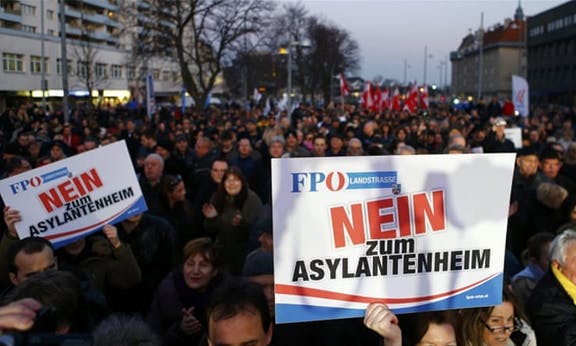Australia isn’t Austria, but fascism can grow here too

Europe’s most successful fascist party is set to enter government after Austria’s federal election on 15 October. Details of a coalition between the racist neoliberals of the conservative Austrian People’s Party and fascists of the Freedom Party are currently being negotiated.
With the failure of the Greens to get over the 4 percent minimum required to gain representation, there is no clearly anti-racist party in the parliament. An alliance between the Communist Party and recently expelled young Greens, the only real left wing option in the elections, received less than 1 percent of votes.
Prior to the election, the Socialist Party, under prime minister Christian Kern, was in coalition with the conservatives. His government attacked Muslim women, banning face coverings in public. That was an initiative of Sebastian Kurz, the minister for foreign affairs and integration, who embraced Islamophobic policies long advocated by the Freedom Party and became the conservatives’ leader in May.
Under the Socialist-People’s Party government, real wages fell while income and wealth inequality rose.
The conservatives are now the largest party in the parliament, having won 32 percent of votes. The fascists had a major electoral success, achieving more than 26 percent, less than 1 percent behind the Socialists.
While the Socialists are keen to negotiate with both the conservatives and the Freedom Party about forming a coalition, the most likely government is a conservative-fascist alliance.
The situation is even more serious than the balance of political forces in France and Germany, where fascists have made major gains this year.
The Alternative for Germany (AfD), now dominated by its Third Reich-admiring right wing, last month became the first fascist party to enter the German parliament in the post-war period, with 13 percent of the vote. Large anti-immigrant protests during 2013-14 gave impetus to the increasingly racist politics of the AfD, which was founded in 2013 as a party opposed to the European Union. It is now dominated by fascists.
The party’s most prominent figure is Alexander Gauland, for many years a member of the “steel helmet” racist and nationalist current in prime minister Angela Merkel’s conservative Christian Democratic Union. Other prominent figures in the AfD are associated with the German “new right”, i.e. fascists attempting to achieve respectability.
Marine Le Pen made it to the second round of the French presidential contest. Her father, Jean-Marie, founded the party in 1972 with the backing of long term fascists and collaborators with the Nazi occupation of France during World War Two. They recognised that being too explicit about their violent hostility to democracy and trade unions was not electorally popular and set up the National Front as a more palatable vehicle for their politics.
The Freedom Party is the direct descendant of the Nazi Party in Austria. The registration of its forerunner in 1949 was promoted by the Socialists, in an attempt to divert the votes of former Nazis, who had until recently been disenfranchised, to the disadvantage of the People’s Party. The Freedom Party’s first leader was a former SS officer.
Between 1983 and 1987, the Socialists gave the Freedom Party, which at the time had a free market liberal wing, additional credibility by making it a junior partner in a coalition government. After the Freedom Party shed its liberal elements, it became a junior partner in a coalition with the People’s Party from 2000 until 2005.
Today, as Hans-Henning Scharsach has demonstrated, the party is dominated by a tightly knit layer of members linked to racist academic fraternities. The fraternities’ intellectual origins go back to the early 19th century, but they assimilated Nazi ideas into their German chauvinist outlook during the Third Reich.
These three fascist parties have used racism and hostility to neoliberal policies implemented by both conservative and social democratic parties to mobilise support. They have been able to draw on substantial far right networks.
A big contrast with Australia?
There is no substantial fascist party in Australia. But the situation here is not fundamentally different from Europe.
The Liberal, National and Labor parties have all implemented racist policies that were previously advocated only by fascists. Most obvious is the suite of policies – boat turn backs, temporary protection visas and concentration camps – that make up Australia’s “border protection” regime. There was also the Northern Territory military intervention against Aborigines and the Cashless Welfare Card legislation.
In Australia, racist attitudes run deep. So does discontent over governments running the country in the interests of big business. At this stage, the additional ingredient of a substantial organisational infrastructure for the spread of fascist influence is still missing.
But reactionaries such as journalist Andrew Bolt and shock jock Alan Jones, as well as Channel Nine and Fairfax media, have publicised their ideas widely by giving media slots to fascists, most recently Milo Yiannopoulos. And the Turnbull government has courted the far right One Nation party in the Senate since last year’s election, helping to normalise it as a political force. Law and order and “public safety” campaigns also promote authoritarian sentiments shared with the far right.
So the fascists enjoy the most favourable ideological ground in decades.
Preventing the emergence of a large fascist organisation requires two things. The first is resistance to racism and other forms of oppression, and resistance to attacks on democracy and workers’ living standards. That can undercut the appeal of authoritarian and bigoted ideas and organisations.
The second is persistent efforts to prevent the emergence of coherent fascist groups. The small organisations already in existence need to be disrupted to prevent their growth. In Melbourne, where they are strongest, the fascists’ morale has been damaged by counter-protests when they have tried to rally and build support.